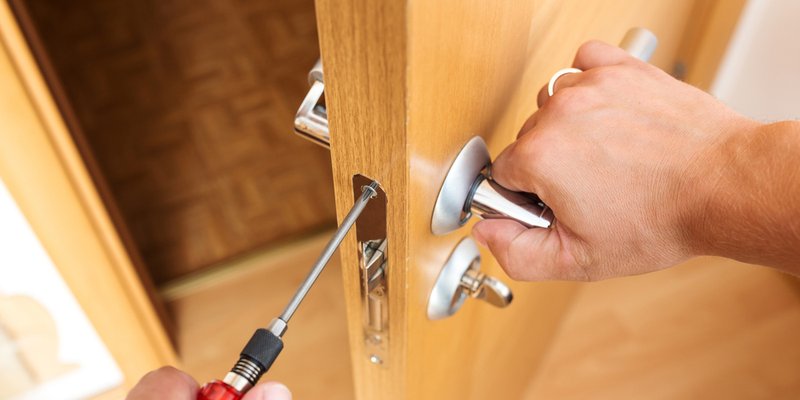
There are a few common culprits behind this issue, and figuring it out doesn’t always require a locksmith. Whether you have a Kwikset, Schlage, or another popular brand, troubleshooting these locks often comes down to basic maintenance and a little patience. Here’s how to dive into the problem so you can get back to your day without that nagging door issue hanging over your head.
Understanding the Problem: Why Is the Lock Hard to Turn?
Before getting your toolkit out, it helps to understand why a keyed interior door lock might be hard to turn. Often, the lock mechanism can get gummed up or misaligned over time. Dust, dirt, or even humidity can make the parts less smooth, much like how a car engine needs oil to run smoothly. Additionally, the key itself can sometimes be the issue. An old or worn-out key might not fit into the lock as snugly as it should.
You might be wondering, “Is it the lock, or is it the key?” A good first step is to inspect your key. If it looks worn or bent, it might not be engaging the lock correctly. A simple test is to insert your key and wiggle it a little. If it feels loose, that could be part of the problem. In many cases, a key that’s hard to turn might be a sign that it’s time for a replacement.
Checking for Dirt and Debris
One of the most common reasons a lock is hard to turn is that it’s simply dirty. Think of it as a dusty old drawer—when it’s stuffed full of old papers and crumbs, it’s hard to open! Locks can accumulate dust and debris over time, creating friction that makes turning the key a challenge.
To clean your lock, you can start by using a can of compressed air. Aim it directly into the keyhole to blow out any loose dirt. If that doesn’t do the trick, a few drops of lubricant can help. Use a graphite-based lubricant, not oil. Oil can attract more dirt and gunk over time. Here’s what to do:
- Insert the key and turn it a few times to help spread the lubricant inside.
- Wipe away any excess lubricant with a clean cloth.
- Repeat if necessary, but remember that a little goes a long way!
Cleaning your lock could be just the solution you need to get it turning smoothly again.
Examining the Key for Damage
If cleaning doesn’t seem to work, take a closer look at your key. Sometimes, we forget that even a small dent or bend can throw things off-kilter. If you notice any irregularities, it could be the reason your lock is hard to turn. A damaged key may not align properly within the lock, causing it to bind.
To test if your key is the problem, try using a spare key, if you have one. If the spare turns the lock easily, then you’ve likely found your culprit. If you don’t have a spare, consider getting a new key cut from your local hardware store. They’ll usually have a machine that can replicate your key accurately.
Ultimately, having a good key can make all the difference in how smoothly your lock operates.
Assessing the Lock Itself
If cleaning the lock and checking the key don’t solve the issue, it’s time to look deeper into the lock mechanism. Sometimes, locks can get misaligned due to changes in temperature or even just due to wear and tear. Imagine a door that’s slightly off its hinges—sometimes, it just needs to be realigned to function properly.
To check for misalignment, close the door and observe if it sits flush within the frame. If there’s a gap or if it feels unusually tight, you may need to adjust the door hinges. Here’s how:
- Inspect the hinges for any visible issues like rust or loose screws.
- Use a screwdriver to tighten any loose screws. If they’re worn out, consider replacing them.
- If the hinges are fine, try using a shim to adjust the door’s position slightly.
Making these adjustments can often resolve the issue, making your lock turn smoothly again.
When to Replace the Lock
Sometimes, despite best efforts, a hard-to-turn lock might be signaling that it’s time for a replacement. If you find yourself continually troubleshooting the same lock or if it’s becoming more frequently problematic, it could be a sign that the lock mechanism is simply worn out.
If you decide to replace the lock, make sure to choose a similar style to ensure easy installation. Look for locks from trusted brands like Schlage or Kwikset. While they may cost a bit more initially, investing in a quality lock can save you headaches later. Here’s a quick rundown of what to consider when shopping for a replacement:
- Look for the same key type (e.g., single cylinder).
- Check the backset size, usually either 2-3/8″ or 2-3/4″.
- Consider the level of security you need, particularly if the door is a primary entrance.
Replacing a lock isn’t as daunting as it sounds. With a few tools and some patience, you can have a new lock installed in no time.
Final Thoughts
Dealing with a keyed interior door lock that’s hard to turn can be frustrating, but more often than not, it’s a problem you can tackle yourself. Start by cleaning out the lock and checking your key for damage. If those steps don’t work, assessing the lock itself for alignment issues might do the trick. And if all else fails, don’t hesitate to replace the lock altogether.
Remember, a little maintenance can go a long way. Just like that creaky floorboard or leaky faucet, regular attention to your home locks can help you avoid bigger issues down the road. So, take a deep breath, roll up your sleeves, and tackle that lock. You’ll be back to opening doors with ease in no time!